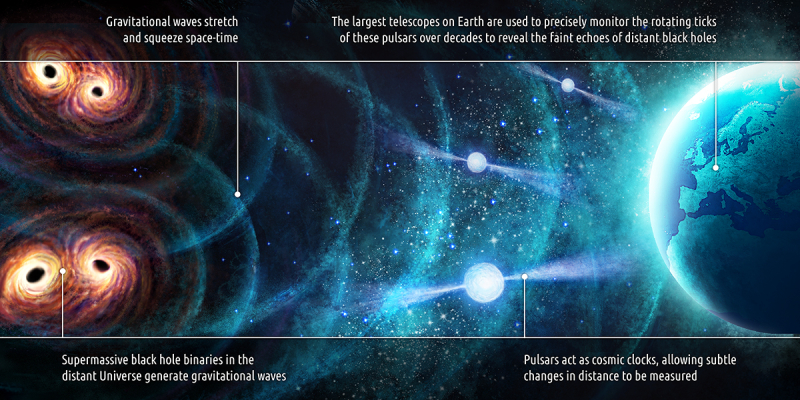Pulsars open a new window for observing gravitational waves
Several scientific Pulsar Timing Array (PTA) collaborations around the world (including the European EPTA collaboration, where the scientists from APC are full members) have joined forces to announce the discovery of a new category of very low-frequency gravitational waves. These very low frequency oscillations in space-time are thought to be caused by pairs of super-massive black holes but could also come from various energetic processes in the early Universe. Stanislav Babak, Director of Research, CNRS-IN2P3/APC, EPTA collaboration member and current IPTA steering committee chairman, gives us some more details.
Why is this discovery an important scientific milestone?
Along with other PTA collaborations1
, we see “some evidence” of the gravitational wave signal in the nano-Hz frequency band. We do not claim detection yet. We must still analyse the combined data from all PTA collaborations for an indisputable result. If this finding is confirmed, it will open a new frequency window (ultra-low frequency between 1 and 100 nano-Hz) in Gravitational Wave Astronomy. Detection of the radio emission from the astronomical object in 1930+ by Karl Jansky started an era of Radio Astronomy followed by many discoveries enriching our understanding of the Universe we live in. Similarly, we are on the verge of looking at the Universe through a new window. We are watching the rolling history of scientific discoveries in slow motion.
What kind of cosmic phenomena can be studied with this “new window”?
There are several sources of gravitational waves in this ultra-low frequency band. Most promising are super-massive black hole binaries, with masses of millions to billions of solar mass each. The population of those super-massive black hole pairs orbiting around each other is believed to produce a stochastic gravitational wave signal. We could also see the signal from individual binaries if they are nearby. There are other possible sources of gravitational wave signals in this band, in particular gravitational waves from various energetic processes in the early Universe. Nevertheless, the exact interpretation of what is the source of those gravitational waves is challenging today.
APC’s scientist have done some surprising theoretical suggestions for this gravitational wave signal. Could you give us an outlook of these ?
Dr. Mikel Falxa (former PhD student at APC, currently a postdoc at the CNRS group in Orleans) was studying the case of the nearby binaries and concluded in one of the ETPA papers that it could come from a binary black hole in the Fornax cluster. It could also be a stochastic gravitational wave signal. Hippolyte Quelquejay, a PhD student at the APC, leads the analysis in this direction. We considered three possibilities for alternative to super-massive black holes:
- A network of cosmic strings could generate the signal.
- It could come from the early Universe when protons and neutrons emerged from the primordial plasma.
- It could be primordial gravitational waves generated during the inflationary expansion of the Universe.
All of these scenarios could potentially produce an observed signal. These are the subjects of the 4th and 5th papers released by the EPTA collaboration.
Can you tell us more about the detection technique you are using?
For several decades, radio telescopes around the world have been monitoring ultra-stable millisecond pulsars. Millisecond pulsars are very old neutron stars emitting a narrow beam of radio light from their magnetic poles. When the beam passes through the radio telescope, it is seen as a "pulse", similar to the signal from the lighthouse. Hence the name "pulsars". We are interested in pulsars with an extremely stable rotation, with pulses arriving at very regular intervals. However, the interval between pulses can vary slightly due to certain effects that change the arrival time of the pulses. Gravitational waves will also induce such deviations but in a very specific manner. Through long-term observations of radio pulsars and sophisticated data analysis techniques, we are trying to disentangle the effect of gravitational waves. In particular, gravitational waves induce a correlated signal in the data from each pulsar, but it is weak and difficult to pick out from the noise. We measure gravitational waves by their interaction with the electromagnetic signals as they propagate from pulsars to Earth, similar to what we measure with the Virgo and LIGO interferometric detectors, but we use lasers and mirrors there.
What is the next step for the collaboration ?
The next step is to combine our (EPTA+InPTA) data with similar data from NanoGrav (North-American collaboration), PPTA (Australian collaboration) and augment with MeerKAT and MeerTime data. These will be the most sensitive data to date, which is already partially ready. It will be analysed jointly by all PTAs under IPTA (International PTA) umbrella. Analysis of these data will likely confirm the detection of gravitational waves. If not... we will need longer observations. 65% of EPTA data comes from Nancay radiotelescope. We have very good receivers and continue monitoring pulsars. In the near future: FAST - a Chinese radio telescope (already in operation), and SKA (Square Kilometre Array) will provide data of very high quality, which will at least improve the sensitivity of PTA by one order of magnitude.
Is this technic going to replace in the future interferometric detection?
No, LIGO, VIRGO and Kagra observe between 10 and 2000 Hz (high frequencies); future space-based mission LISA (launch 2035) will operate 0.1 to 100 milli Hz (low frequencies). PTA is complementary; it observes in the range 1 nano Hz -100 nano Hz (ultra-low frequencies). These projects are complementary to each other.
- 1NanoGrav, PPTA, CPTA

À propos d'EPTA
EPTA is a collaboration of scientists from eleven European institutions, bringing together astronomers and theoretical physicists to use observations of ultra-regular pulses from the remnants of stars, known as pulsars, to build a galaxy-sized detector of gravitational waves. InPTA also brings together scientists from several Indian and Japanese institutes in a single consortium.
IN2P3 is involved in EPTA project through the APC laboratory which, together with the DPHP/CEA, provides expertise in the statistical analysis and interpretation of the gravitational signal. The project has also required intensive use of the CC-IN2P3 computing centre to carry out the gravitational analysis (with, for example, 2.9 million CPU computing hours since 2021).
